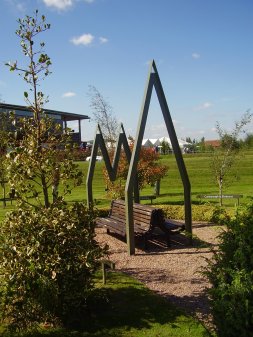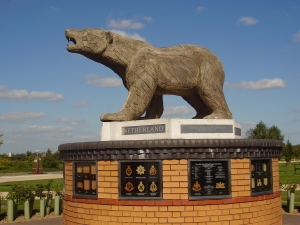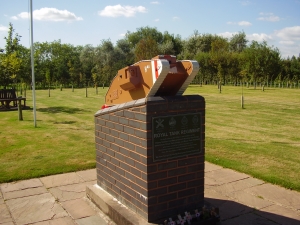The National Memorial Arboretum
After years of talking about visiting the Arboretum at Alrewas, we finally made the journey on Thursday August 27th 2009. After parking up, we entered the reception area, and were welcomed by one of the reception personnel,who gave us a brief introduction of the layout of the site.
Armed with our book and map, we set off along the Blue route, to look for the Fire service, and the Civil Defence memorials, as a starting point.
The Fire & Rescue Memorial, Plot 223, Dedicated May 2008

The monument dedicated to the Fire & Rescue Service, comprises of a 6.5 Ton block of red granite, surmounted with a stainless steel and enamel replica of the Fire Service Badge. The 8 points or tenets of the Fire Service star, represent the qualities required of a fire fighter. Tact, Gallantry, Dexterity, Observation, Perseverance, Loyalty, Explicitness, and Sympathy.
The Civil Defence Memorial, Plot 225, Dedicated June 2001

The large memorial stone, commemorates the 1,900,000 who served in the Civil Defence during WWII, and the 7,000 who lost their lives. The smaller stone, reminds us of the service given by animals during that time.
At the back of the Civil Defence plot is the memorial to the volunteer services, of the Civil Defence Corps, & the Auxiliary Fire Service, between 1949 and 1968. Unveiled in 2008.
Civil Defence Corps & Auxiliary Fire Service Memorial 1949 to 1968.
Having an interest in Railways we visited the memorial to the Sumatra Railway, plot 228. This railway was constructed in extreme conditions around the Equator, by 5,000 allied prisoners of war, and also 30,000 local people. The railway was completed on August 15th ( VJ – Day), so it was never used apart from transporting the prisoners of war back to civilisation. Along the track bed are some of the tools, used in the original construction.

Memorial 228 The Sumatra Railway
Memorial No 214 is in memory of the Fauld Explosion, which was the largest explosion in the United Kingdom. In 1937 the Air Ministry purchased an old disused Gypsum mine at Fauld, near Hanbury, which is about 12 miles from the Arboretum. The purpose of this, was for the underground storage of weapons and bombs for the Royal Air Force.

Memorial No 214 The Fauld Explosion.
The explosion occurred at 11-11 on the 27th of November 1944, when 4,000 tons of bombs and ammunition exploded underground, leaving a crater half a mile wide and 100 feet deep.

In total 78 people lost their lives in the disaster, and every house in Tutbury was severely damaged. The local pub lost its roof and Upper Hayes Farm disappeared completely. The blast was reputed to have been heard at Weston Super Mare, and shock waves recorded at Casablanca.
Memorial No 211 is in respect of The Bevin Boys, and comprises of a plaque and bench. During World War 11 there was a shortage of skilled Colliery workers, so between 1943 and 1948, nearly 48,000 young men were conscripted to join the miners, in their dirty and dangerous jobs, at the coal face. Life was extremely hard for these young men, and many lost their lives, in helping to keep the essential coal supplies flowing.

Memorial 211 The Bevin Boys Plaque.
Leaving the Blue Route, we then made our way to the magnificent Armed Forces Memorial, erected in memory of the Great sacrifices made by our armed forces, in conflict, or whilst on training exercises.

Dedicated on 12th October 2007, by Her Majesty the Queen, the memorial stands on a 6 metre high earth mound, 100 metres wide at the base, and tapering to 50 metres wide at the top. The memorial is accessable by a flight of steps, with disabled access by means of a gentle spiraling walkway easily negotiated by wheelchairs and mobility scooters. At the top, 200,000 Portland stone faced panels, engraved with the names of the fallen, form a 43 metre round structure. Inside the stone walls are two life size bronze sculptures depicting loss and sacrifice.


At the entrance to the circular walled section stands an obelisk and a large stone wreath is in the centre of the structure.


Having paused to reflect for a while, we made our way slowly down the spiral walkway, to look for the monument in aid of the RNLI.

Memorial No 337 The Royal National Lifeboat Institution.
On our way back to the main building, we passed an impressive monument, of a life size, ATS girl sitting on a rock.

Memorial No 208 The Auxiliary Territorial Service
As time was now drawing on, we made our way back to the main building and exit. Suitable impressed with our visit, and knowing that there were lots more to see, we returned home with a view to study the brochure, compile a list of more memorials we would like to view, and make a return visit in the very near future.
Our second visit to the Arboretum, took place on Thursday September 12th 2009, to continue our tour of the memorials.
Site 210, situated outside the Chapel, is the Amphitheatre dedicated to Group Captain Leonard Cheshire VC,CH,DSO,DFC, the founder of the Cheshire homes. Located on the raised bank of the amphitheatre’ is a large brass bell, presented by Les Wills, who retired from the West Midlands Fire Service in 1987, where he held the position of Assistant Chief Fire Officer (operations).

The bell started life on a Bedford Fire Engine, which operated in the city of Birmingham, during the period of 1960 to 1970. It is rung daily shortly before the Arboretum closes.
Site 230 is a memorial to the 25,000 prisoners of war, who were forced to build the Burma Railway, between September 1942 and October 1943. It is constructed with 100 feet of the original track which was brought in from Thailand in 2002.

It was known as the Railway of Death, as 16,000 prisoners of war, lost their lives during the construction.

Plaque on the Burma Railway (FEPOW stands for Far East Prisoners of War)
Along Millenium avenue, we have a memorial dedicated to all those who served as National Service men, between 1939 and 1960.

Situated in position 207, the green granite sculpture was unveiled on the National Service Day of June 29th 2003.
Also along Millenium Avenue is the memorial No 351 Gallipoli.

The feature of this monument, shows a number of dead Oak trees standing vertically, out of the ground. These trees have been trimmed to represent the arms and hands, of the injured soldiers, who as they lay in the deep mud alongside their dead comrades, reached upwards with the slim hope of rescue.
The Lichfield and district garden occupies the area numbered 209.

The centre seat design, represents the 3 spires of Lichfield Cathedral, and trees, representing each parish of Lichfield, have been planted in geographical positions around the central feature.
Plot 307 brings us to the Polar Bear Memorial, in respect of the 49th Infantry, West Riding Division. The 2.5 Tonnes yellow hardwood bear, stands 5 feet high, with an overall length of 9 feet, and is mounted on a large plinth. The Polar Bear was adopted as the regimental mascot, when the company was stationed in Iceland, during the second world war.

Six men from the Essex Wood carvers, spent 6 months carving this impressive hardwood statue. Dedicated on 7th June 1998, this polar bear tribute was the first monument to be erected at the Arboretum.
Leaving the hard paved area I then crossed the grassed section towards the river. The first memorial I found was the Royal Tank regiment.

The first battle involving tanks commenced on September 15th 1916, at the Somme. Thirty tanks attacked the German positions between Flers, and Courcelette, resulting with more than 1,000,000 casualties. On November 20th 1917,300 MK4 tanks, successfully fought at Cambrai. This battle was the beginning of serious tank warfare, and signalled the end of fighting in the trenches.
The Royal Corps of Signals have a fine statue of Mercury at 325a.

The memorial was unveiled in May 2008, by The Princess Royal, who is the regiments Colonel in Chief.
Finishing touches were being carried out to the Polish Forces War Memorial on site No 327a

This memorial which commemorates the lives lost by Polish men, women, and children, is scheduled to be unveiled on Saturday September 19th 2009.
A short walk then brings one to the statue depicting the 306 soldiers, who were shot for cowardness or desertion, during the first world war. The statue situated on plot 329, is in the most easterly point of the Arboretum, and the first place to catch the dawn light. Many of the soldiers who were shot, were suffering from shell shock, or post traumatic stress, and several were under age. The life size statue is based on Private Herbert Burden, who was just 17 years old, when he faced the firing squad in 1915 at Ypres. Immediately behind the monument, are 306 wooden stakes driven into the ground. These stakes represent the soldiers executed, one for each serviceman, bearing a plaque engraved with, the individuals name and details.

In 2006, following a campaign in the High Court, a pardon was granted for the unfortunate soldiers, who met their end in this way.
Site 330a represents the Snowman’s Guild of Great Britain, which is the association for the travelling Fun Fair Industry.

As well as a fine monument, also displayed on the site is a typical horse which is found on the Golden Galloper’s ride.

The memorial to the RAF No 30 squadron which was formed in 1915, is on site No 341a. The squadron flew Blenheim’s, and carried out many bombing raids during the second world war.

From the late 1940’s the 30 squadron was responsible for air transport, and developed from Douglas Dakota aircraft, to the present day C130 Hercules, operating world wide.
An impressive Golden Eagle landing on a brickwork plinth, constructed with Staffordshire blue engineering bricks, commemorates all who served in the Royal Auxiliary Air Force.

This monument , resident on position 343 was officially dedicated in September 2002 by HRH The Duke of Gloucester.
Another RAF memorial is next on area known as 344a. This structure is for the RAF Police or Snowdrops, as was their forces nickname, instigated through wearing white hats.

Formed in 1918, by 1945 the division consisted of 20,000 personnel, and up to date have served in 66 countries, and are still involved in defeating terrorism today.
September 26th 1999 saw the dedication of plot No 101 in respect of operation Dynamo. This tremendous event saw the evacuation of 338,000 troops from the beaches of Dunkirk, and returned them safely to England. The operation was carried out by the Royal Navy, the Merchant Navy, Allied ships, and a mixed fleet of various small, privately owned boats manned by civilian volunteers.

The final gathering of the Dunkirk Veterans Association took place at this dedication before being disbanded on June 14th 2000. The average age at that time was 82 years.
A small remembrance garden houses a memorial to the Ambulance Service. It is a tribute to all ambulance personnel who have died, in particular to those killed whilst on duty. Known as No 107 it was dedicated on September 16th 2004 in the presence of Rosie Winterton, who held the position of, Minister of State of Health, at that time.

Ambulance Service Memorial. Patron Simon Weston OBE.
The adjacent area No 108 contains a monument to Queen Alexanders Royal Nursing Corps. Founded in 1902 as Queen Alexanders Imperial Military Nursing service, it was given the current Royal title in 1949.

When not on active service, they provide care to servicemen, and civilians in the United Kingdom, Germany, Cyprus, Brunei, and Belize.
After spending the second day surveying the excellent creations and tributes, to the various groups, both Military and Civilian, who dedicate their life, and in some cases their lives, to serving humanity, we headed for home, vowing to return again, to pay our respects, to those who gave their all for us.
September 11, 2009 at 7:30 pm |
First class stuff, sir!
September 12, 2009 at 8:40 pm |
Thanks for comment Godfrey
September 14, 2009 at 7:30 am |
Lovely post – beautifully photographed and well written.
Best wishes
Bob
September 18, 2009 at 11:12 am |
Thanks for the comment Bob, after visiting the Arboretum for the first time I was so taken with the place, I felt that I must record it. Kind regards Godfrey
September 15, 2009 at 1:10 pm |
Thanks for the comment Bob, after visiting the Arboretum for the first time I was so taken with the place, I felt that I must record it. Kind regards Godfrey
July 22, 2010 at 9:15 am |
Many thanks for your efforts.
This whole site is a goldmine and I will return to enjoy it again and again!
July 25, 2010 at 12:00 am |
Thanks John for your kind comments. I’m pleased you enjoyed the article Kind regards Godfrey (oakparkrunner)
August 27, 2010 at 2:19 pm |
well put together I have visited twice and being disabled the service of the volunteers was first class every year more to see and reflect on thank youyours vic richards
November 5, 2010 at 3:55 pm |
[…] Dunkirk Veterans, The National Memorial Arboretum, UK (oakparkrunner) / Amar Jawan Jyoti (la flamme du guerrier immortel), au centre de l’India Gate à New Dehli (Courtesy from Vijay Pandey on Flickr, © Tous droits réservés) / Porte d’entrée d’un cimetière et mémorial du LTTE (Mouvement des Tigres de Libération de l’Eelam Tamoul) à Jaffna, Sri Lanka, représentant probablement des fusils FAL belgo-britannique, (Courtesy from Ananthan on Flickr, © Tous droits réservés) […]
September 24, 2012 at 1:53 am |
I am sure this paragraph has touched all the internet viewers,
its really really fastidious paragraph on
building up new website.